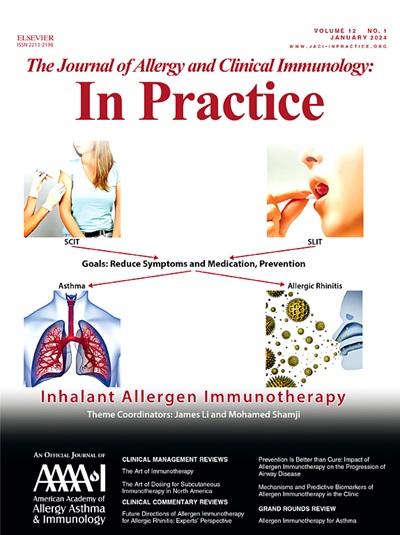Management of Chronic Spontaneous Urticaria Made Practical: What Every Clinician Should Know
IF 6.6
1区 医学
Q1 ALLERGY
Journal of Allergy and Clinical Immunology-In Practice
Pub Date : 2025-09-01
DOI:10.1016/j.jaip.2025.07.021
引用次数: 0
Abstract
Despite its significant impact on quality of life, optimal management of chronic spontaneous urticaria remains challenging because of knowledge gaps regarding triggers, treatment response variability, and limited data for special populations. Second-generation H1-antihistamines are the first-line treatment and effective in approximately 50% of patients. For those who remain symptomatic, up-dosing up to fourfold is safe and recommended. However, prolonged ineffective antihistamine therapy should be avoided to prevent delayed disease control. In such cases, timely escalation to biologics, particularly omalizumab, is essential. Omalizumab remains the cornerstone of biologic therapy, offering rapid and sustained efficacy with an excellent safety profile. Personalized approaches involving dose escalation or interval adjustments further optimize outcomes. Cyclosporine A serves as an effective third-line option, particularly for autoimmune chronic spontaneous urticaria, but requires close monitoring because of dose-related adverse effects. Special considerations for children, pregnant individuals, and elderly people are discussed, reflecting the need for tailored approaches. Trigger avoidance, particularly nonsteroidal anti-inflammatory drugs, may aid management, although evidence is limited for many suspected exacerbating factors. Regular assessment of disease activity and control using validated tools such as the Urticaria Activity Score and Urticaria Control Test is essential for guiding treatment decisions and monitoring response. Updated international guidelines are anticipated to address emerging therapies and current knowledge gaps.
慢性自发性荨麻疹的治疗:每个临床医生都应该知道的。
尽管它对生活质量有重大影响,但慢性自发性荨麻疹的最佳管理仍然具有挑战性,因为关于触发因素的知识差距,治疗反应的可变性,以及特殊人群的有限数据。第二代h1 -抗组胺药是一线治疗,对大约50%的患者有效。对于那些仍有症状的人,建议将剂量增加至四倍是安全的。然而,应避免长期无效的抗组胺治疗,以防止延迟疾病控制。在这种情况下,及时升级到生物制剂,特别是奥玛珠单抗,是必不可少的。Omalizumab仍然是生物治疗的基石,提供快速和持续的疗效,并具有良好的安全性。包括剂量递增或间隔调整的个性化方法进一步优化了结果。环孢素A是一种有效的三线治疗选择,特别是对于自身免疫性慢性自发性荨麻疹,但由于剂量相关的不良反应,需要密切监测。还讨论了对儿童、孕妇和老年人的特别考虑,反映出需要采取有针对性的办法。避免触发,特别是非甾体抗炎药,可能有助于管理,尽管证据有限,许多可疑的加剧因素。使用经验证的工具(如荨麻疹活动评分和荨麻疹控制测试)定期评估疾病活动和控制情况,对于指导治疗决策和监测反应至关重要。更新的国际指南有望解决新出现的治疗方法和目前的知识差距。
本文章由计算机程序翻译,如有差异,请以英文原文为准。
求助全文
约1分钟内获得全文
求助全文
来源期刊

Journal of Allergy and Clinical Immunology-In Practice
ALLERGYIMMUNOLOGY-IMMUNOLOGY
CiteScore
11.10
自引率
9.60%
发文量
683
审稿时长
50 days
期刊介绍:
JACI: In Practice is an official publication of the American Academy of Allergy, Asthma & Immunology (AAAAI). It is a companion title to The Journal of Allergy and Clinical Immunology, and it aims to provide timely clinical papers, case reports, and management recommendations to clinical allergists and other physicians dealing with allergic and immunologic diseases in their practice. The mission of JACI: In Practice is to offer valid and impactful information that supports evidence-based clinical decisions in the diagnosis and management of asthma, allergies, immunologic conditions, and related diseases.
This journal publishes articles on various conditions treated by allergist-immunologists, including food allergy, respiratory disorders (such as asthma, rhinitis, nasal polyps, sinusitis, cough, ABPA, and hypersensitivity pneumonitis), drug allergy, insect sting allergy, anaphylaxis, dermatologic disorders (such as atopic dermatitis, contact dermatitis, urticaria, angioedema, and HAE), immunodeficiency, autoinflammatory syndromes, eosinophilic disorders, and mast cell disorders.
The focus of the journal is on providing cutting-edge clinical information that practitioners can use in their everyday practice or to acquire new knowledge and skills for the benefit of their patients. However, mechanistic or translational studies without immediate or near future clinical relevance, as well as animal studies, are not within the scope of the journal.
 求助内容:
求助内容: 应助结果提醒方式:
应助结果提醒方式:


